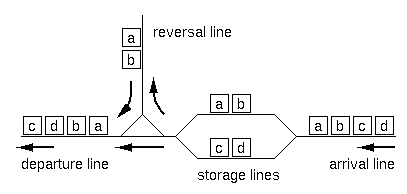POJ Organize Your Train part II 3007
来源:互联网 发布:淘宝卖家在哪里登录 编辑:程序博客网 时间:2024/05/21 11:36
Description
RJ Freight, a Japanese railroad company for freight operations has recently constructed exchange lines at Hazawa, Yokohama. The layout of the lines is shown in Figure 1.

Figure 1: Layout of the exchange lines
A freight train consists of 2 to 72 freight cars. There are 26 types of freight cars, which are denoted by 26 lowercase letters from "a" to "z". The cars of the same type are indistinguishable from each other, and each car's direction doesn't matter either. Thus, a string of lowercase letters of length 2 to 72 is sufficient to completely express the configuration of a train.
Upon arrival at the exchange lines, a train is divided into two sub-trains at an arbitrary position (prior to entering the storage lines). Each of the sub-trains may have its direction reversed (using the reversal line). Finally, the two sub-trains are connected in either order to form the final configuration. Note that the reversal operation is optional for each of the sub-trains.
For example, if the arrival configuration is "abcd", the train is split into two sub-trains of either 3:1, 2:2 or 1:3 cars. For each of the splitting, possible final configurations are as follows ("+" indicates final concatenation position):
[3:1] abc+d cba+d d+abc d+cba [2:2] ab+cd ab+dc ba+cd ba+dc cd+ab cd+ba dc+ab dc+ba [1:3] a+bcd a+dcb bcd+a dcb+a
Excluding duplicates, 12 distinct configurations are possible.
Given an arrival configuration, answer the number of distinct configurations which can be constructed using the exchange lines described above.
Input
The entire input looks like the following.
the number of datasets = m
1st dataset
2nd dataset
...
m-th dataset
Each dataset represents an arriving train, and is a string of 2 to 72 lowercase letters in an input line.
Output
For each dataset, output the number of possible train configurations in a line. No other characters should appear in the output.
Sample Input
4aaabbaabcdabcde
Sample Output
161218
Source
题意:
给定一个字符串,从任意位置把它切为两半,得到两条子串
定义 子串1为s1,子串2为s2,子串1的反串为s3,子串2的反串为s4
现在从s1 s2 s3 s4中任意取出两个串组合,问有多少种不同的组合方法
分析:主要是哈希,一开始用的set,超时,最后用了一个不是太好的哈希
烂代码
#include <iostream>#include <string.h>#include <stdio.h>#include <stdlib.h>#include <algorithm>#include <set>using namespace std;#define inf 40007char str[500][80];struct node{ int g; struct node *next;};struct node *h[50000],*p,*q,*r;int top=0;int ct=0;void lianjie(char s1[],char s2[]){ char ss1[100]; strcpy(ss1,s1); int i,j; char ss[100]; int ans=0; strcpy(ss,strcat(ss1,s2)); int l=strlen(ss); for(i=0;i<l;i++) { ans+=((ss[i]-'a'+1)*(i+1)); } ans%=inf; if(h[ans]==NULL) { strcpy(str[top],ss); p=new node; p->g=top; p->next=NULL; top++; h[ans]=p; ct++; } else { int flag=0; q=h[ans]; while(q) { if(strcmp(str[q->g],ss)==0) { flag=1; break; } q=q->next; } if(!flag) { q=h[ans]; while(q->next) { q=q->next; } strcpy(str[top],ss); p=new node; p->g=top; p->next=NULL; top++; q->next=p; ct++; } }}void f(int l,int r,char s[]){ int i,j; char s1[100],s2[100],s3[100],s4[100]; for(i=0;i<l;i++) { s1[i]=s[i]; s2[l-i-1]=s[i]; } s1[l]=s2[l]='\0'; for(i=l;i<r;i++) { s3[i-l]=s[i]; s4[r-i-1]=s[i]; } s3[r-l]=s4[r-l]='\0'; lianjie(s1,s3); lianjie(s3,s1); lianjie(s2,s3); lianjie(s3,s2); lianjie(s1,s4); lianjie(s4,s1); lianjie(s2,s4); lianjie(s4,s2);}void init(){ ct=0; for(int i=0;i<=49999;i++) { h[i]=NULL; } top=0;}int main(){ int n,m,i,j; char s[100]; scanf("%d",&n); while(n--) { init(); scanf("%s",s); int l=strlen(s); if(l==1) { printf("1\n"); } else { for(i=1;i<l;i++) { f(i,l,s); } printf("%d\n",top); } } return 0;}- POJ 3007 Organize Your Train part II
- POJ 3007 Organize Your Train part II
- POJ 3007 Organize Your Train part II
- POJ 3007:Organize Your Train part II
- poj-3007 Organize Your Train part II
- poj 3007 Organize Your Train part II
- POJ 3007 - Organize Your Train part II
- poj 3007Organize Your Train part II
- POJ Organize Your Train part II 3007
- poj-3007-Organize Your Train part II
- POJ 3007.Organize Your Train part II
- POJ 3007 Organize Your Train part II map+string
- POJ 3007 Organize Your Train part II(枚举)
- 【POJ 3007】 Organize Your Train part II (字符串HASH)
- Organize Your Train part II【POJ--3007】【平衡二叉树】
- [POJ 3007]Organize Your Train part II[Hash][Trie]
- POJ-3007 Organize Your Train part II (字符串hash)
- poj 3007 Organize Your Train part II 哈希判重
- WebRTC的native层语音处理
- 百度前端技术学院第一题
- Android中的Animation(动画)详解及简单使用_项海涛
- JDK环境变量配置的步骤
- ResultSet 结果集查询数据库
- POJ Organize Your Train part II 3007
- 【扩展】StarUML
- ANSI-美国国家标准学会
- C++笔记二
- 单例设计模式 java
- 交叉熵损失函数
- Unity3D移动平台内存优化
- 喜欢穿衬衫的你 真的会选“衬衫”吗?
- Write and read opencv3.0 ml files(random forest)


